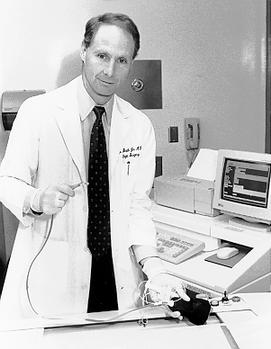Technique relieves enlarged prostate

Dr. Joseph Smith Jr. with the Prostatron, a new device that may provide an alternative to surgery for those suffering from enlarged prostate.
The same technology used by a microwave oven may provide an alternative form of relief for symptoms of an enlarged prostate.
Vanderbilt University Medical Center is the first center in the region and one of only 10 nationwide to offer the new technique, called transurethral microwave thermotherapy. The U.S. Food and Drug Administration approved use of the "Prostatron" machine last year for treatment of men with symptomatic benign prostatic hyperplasia (BPH).
"This is a non-invasive way to treat prostate enlargement that can offer a much more attractive alternative to life-long medicines or surgery," said Dr. Joseph A. Smith Jr., William L. Bray Professor and chair of Urologic Surgery.
Thermotherapy uses microwave energy to heat the cells of the prostate – a male reproductive gland about the size and shape of a walnut that is wrapped around the urethra, the tube that carries urine from the body.
The prostate cells are heated to about 43 degrees Centigrade. Normal body temperature is 37 degrees Centigrade.
"That's not a great enough temperature to kill cells, at least not when it's delivered for a very short time, but it does alter their metabolism," Smith said.
"The precise way in which thermotherapy alters the cells' metabolism and produces favorable results is not known, but it is believed that it changes some of the nerve receptors in the cells. That allows the cells to relax, which permits greater urine flow."
Prostate enlargement is a common condition that affects men as they grow older. The condition often causes a frequent need to urinate and a decrease in urine flow.
"Men don't even have to be that old to be affected," Smith said. "Usually past the age of 50, almost all men have some degree of prostate enlargement."
It is estimated that about 7.5 million men have BPH, with about 250,000 men needing prostate surgery every year, according to the National Institutes of Health.
As the nation's multitude of Baby Boomers move into their 50s and 60s, the incidence of BPH is expected to grow accordingly. By the year 2000, it is estimated that about 9 million men will have symptoms of BPH, the NIH says.
Thermotherapy is a one-time outpatient procedure, requiring no anesthetic or sedation, and it takes about an hour, Smith said.
A special catheter is inserted through the urethra into the bladder. The catheter performs three functions: emitting the microwave energy, monitoring temperature and cooling the urethra so that it is not damaged during the procedure.
"The machine continuously plots and measures the temperatures," Smith said. "If it gets too hot, the machine cuts back on the microwave energy, and if the cells are not warm enough, the machine heats them back up."
Results of thermotherapy have been studied for several years in Europe, Smith said.
"At least half of men who have significant urinary troubles have substantial improvement after undergoing one treatment with thermotherapy," Smith said.
"Of course, that means that almost half of them don't get a whole lot better with it, but because it is non-invasive, it may be an option for a man to try before going to surgery or committing himself to taking a medication for the rest of his life."
Currently, most insurance plans cover thermotherapy for symptomatic BPH, Smith said.
Research is also being done to investigate whether the technique has an effect on cancerous prostate cells and recurrent prostate infections, Smith said. Investigators at VUMC plan to participate in some of those clinical trials.
For more information about prostate enlargement, thermotherapy or other treatments, call 322-2880.













